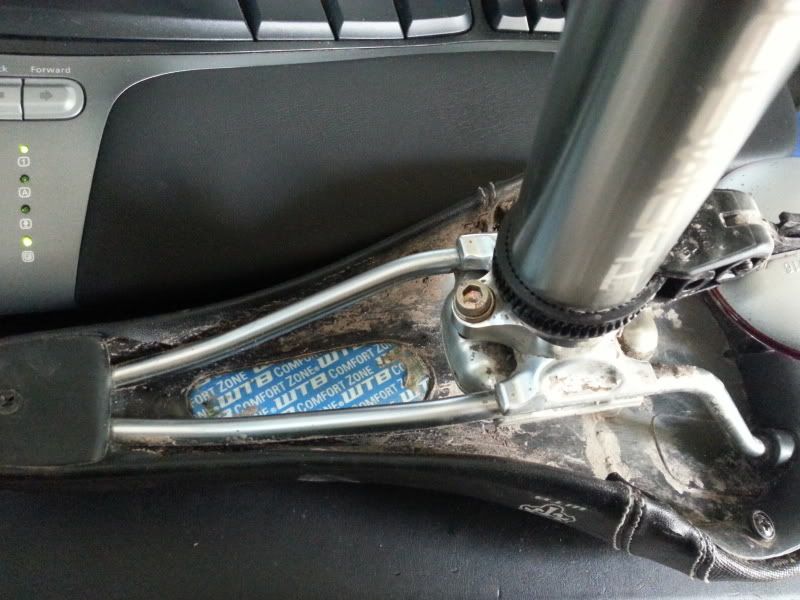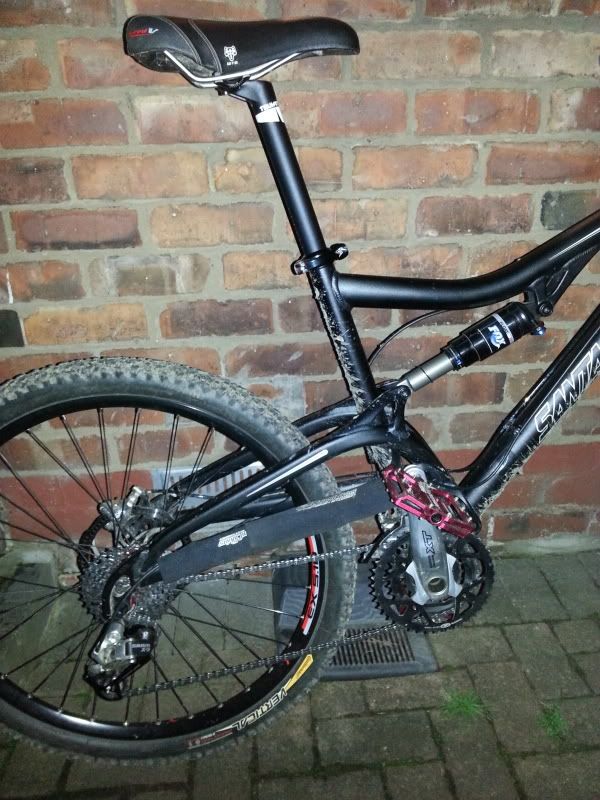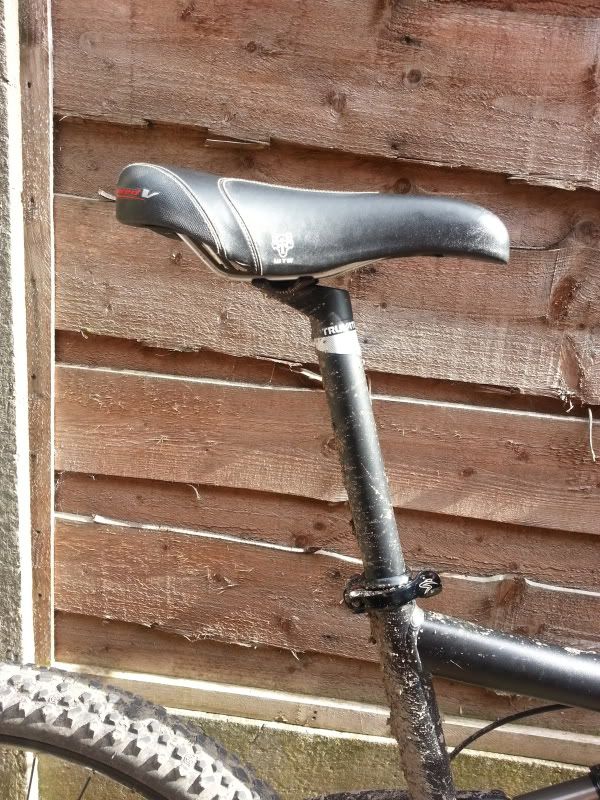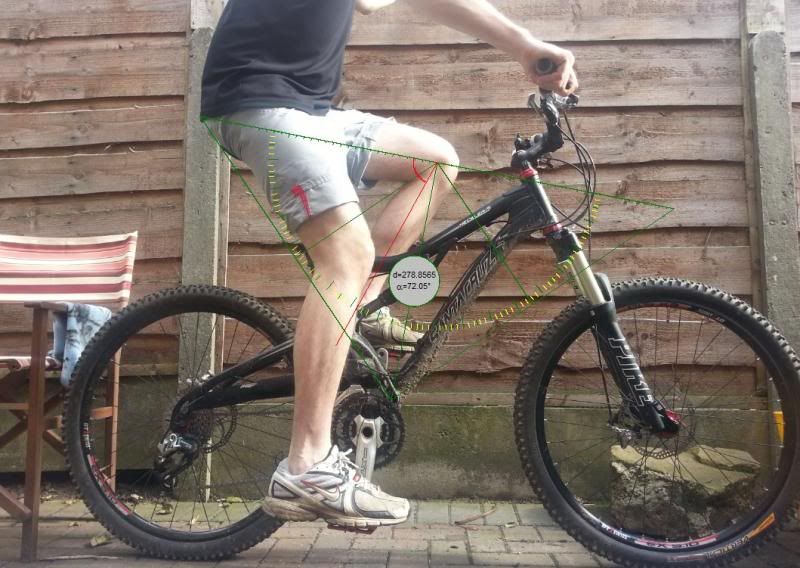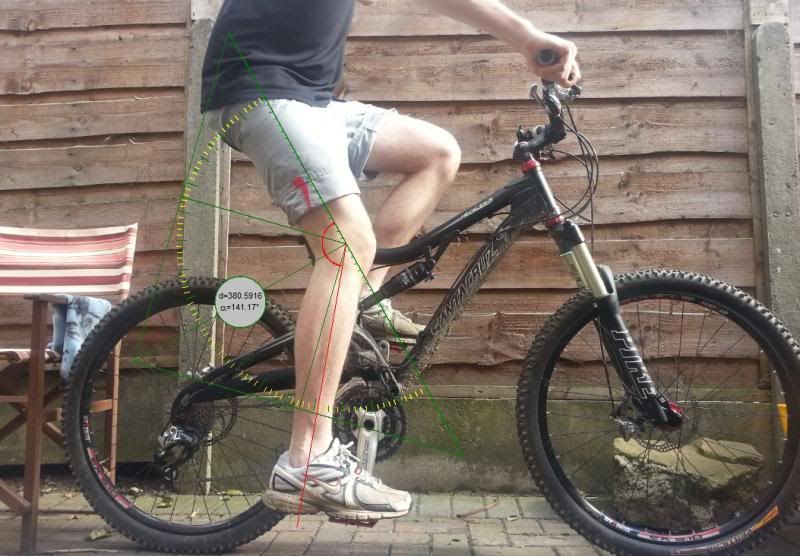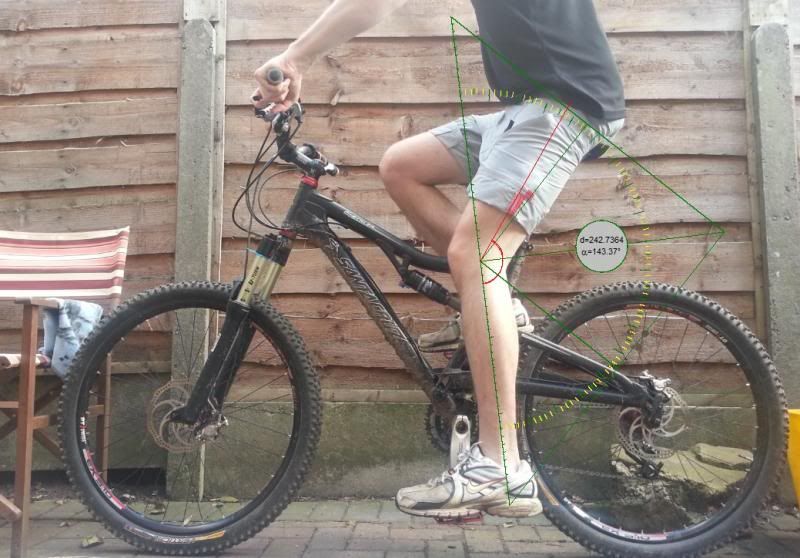- This topic has 64 replies, 34 voices, and was last updated 10 years ago by cruzcampo.
-
Saddle too high? Medial knee pain, with pictures on bike…
-
DanWFree MemberPosted 10 years ago
Serious question: Why is sitting almost upright an inefficient riding
Afaik it isn’t.
Different muscles become more or less active through different ranges of motion. If you are asking smaller weaker muscles to do a lot of the work they will fatigue quickly and the soft tissues in the area may get damaged with overuse. Likewise neighboring joints may have to do more/ less work to compensate for a joint doing its less than optimal proportion of work. Think about the difference in sitting bolt upright (pelvis tilted pretty much the same as standing) and pedaling and then tilting the pelvis forwards perhaps 30 degrees with the upper body around 40-45 degrees to the horizontal and pedaling. The range of motion at the hip (femur relative to pelvis) is very different in each case and will recruit different muscles and likely have knock on effect down to the knee and ankle and up to the back.
Peddling from the glutes, i.e. engaging bum muscles when peddling
I am less sure on the specifics for cycling but would imagine that you will struggle to engage the glutes for example with such an upright position. Maybe a physio can add some information here.
Keeping heel down when at the bottom of the pedal stroke
I think this is the opposite of what a physio/ bike fitter would suggest. You are kind of saying you don’t want the gatrocs (calves) to do too much work keeping the heel down. While it might reduced knee pain (gastocs attach behind the knee and are passive flexors of the knee if you like) taking them out of the equation means the knee and hip have to do a bit more work. There are mixed view on this (see mid foot cleat positions). Again maybe a physio can give their thoughts.
As suggested above, moving the saddle back on the rails would be a good move for general bike fit. But I don’t think you need a new bike.
I would agree that the saddle is quite far forwards. Whether or not a layback post (the Thomson suggested by the OP is only around 15-16mm by the way)can compensate for the too small frame is the question. It might be good to try it initially.
I would be very wary of following the “rules” CaptainMainwaring suggests as they are only a rough guide to give a starting point on fit as I have already said.
I don’t think the way forwards is to “spend” your way out, with new frame etc, you would be better spending the money on a good physio that understands cyclists and who can cure the actual physical injury, not buy a new bike and hope your knee gets better.
You kind of need both. No point having a bike fit with a dodgy knee but equally no point fixing the knee and aggravating it again with a poor fit on the bike. I would be looking to see a decent physio ASAP to take care of the knee side of things and let them help you with any imbalances you might have and check there might not be some underlying pathology. After that focus on the bike and the fit. It needn’t cost a lot of money to try a larger frame. A second hand hardtail frame might not be the glamorous option but for £100 or so it would give you and the bike fitter a better platform to work with in trying to get comfortable on the bike.
Email a few bike fitters the pictures you have posted here. My bet is that they will say they can do as much for you as possible but to not expect too many drastic changes in comfort and that most likely a bigger frame (longer top tube) would give them a better chance of getting you as comfortable as possible. I would also imagine that they wouldn’t be super keen on fitting with flat pedals as they tend to put the feet in positions too far away from where they would like to fit and people tend to rotate their feet in ways they wouldn’t on clipless pedals. It is hard to explain but see what they say. It could be worth a few emails just to know where you stand and what you might need to invest in (physio/ fit/ frame) in the near future.
TiRedFull MemberPosted 10 years agoa layback seatpost would help.
A vertical line from the pedal axle when the crank is horizontal should be just on the front of the kneecap
These two terms are at odds. Set the saddle in the correct position according to the knee, Then determine the reach to the bars. Do NOT move the saddle back to accomodate poor fit, that will exacerbate the knee pain. A layback saddle will just require that the saddle be placed further forward on the rails.
I find the 108% and heel on pedal rules tend to position the saddle too high with a knee bend of about 20 degrees. And they are of course subjective, depending on the seat tube angle. I prefer 25 degrees with knee over pedal. This is valid for all frame angles.
Just fit a longer stem. You won’t die, and it’s a little bit retro 😉
DanWFree MemberPosted 10 years agoa layback seatpost would help.
A vertical line from the pedal axle when the crank is horizontal should be just on the front of the kneecap
These two terms are at odds. Set the saddle in the correct position according to the knee, Then determine the reach to the bars. Do NOT move the saddle back to accomodate poor fit, that will exacerbate the knee pain. A layback saddle will just require that the saddle be placed further forward on the rails.
This is correct besides the first sentence. The OP is quite far forwards over the pedals so needs point one (the layback post) to satisfy point 2 (the horrible rule of thumb 😀 )
I definitely agree with setting the saddle to pedal relationship first then getting the reach correct. I would say the saddle to pedal relationship isn’t really right for the OP which is why this might need some adjustment first. As before though, it is hard to tell from static photos and a fitter/ physio will be able to help more.
Just fit a longer stem. You won’t die, and it’s a little bit retro 😀
A longer stem might help but given how upright the OP is sat it might have to be one of those custom 15cm jobbies one if the Astana riders was using 😯 😀 (this is a joke, just in case it is not clear)
TiRedFull MemberPosted 10 years agoI’ve got two 120mm stems. He can have one for the cost of postage 😉 . And that 160cm stem is suitable for gibbons and not much else! It was a custom abomination. MUst want a VERY low position.
ClobberFree MemberPosted 10 years agoI’m similar sized and getting on an XL made the world of difference for having the right shaped cockpit for pedalling, far more efficient and comfortable for me.
crispycrossFree MemberPosted 10 years agoJust an observation here. You may only have jumped on the bike quickly to take the photos, but your foot looks quite a way forwards on the pedals. A common rule-of-thumb (so take with a pinch of salt, as has been said many times before) is for the ball of your foot to be more-or-less over the pedal axle. Foot further forward = effectively shorter leg-foot system, especially if combined with a pedal stroke that flexes the ankle at the bottom of the stroke. Also, you may pedal in a more toe-down or heel-down style. Any given saddle height formula (x times inside leg etc…) cannot account for this difference in pedalling technique so what’s a ‘good’ height for one style may be too high or low for another. A static photo can’t show this.
I guess what I’m saying is, get a bike fit first, where someone who knows what they’re on about can see you actually pedalling, and pedalling hard. This can be from an experienced rider, or your friendly LBS, better from a qualified bike fitter, best of all from somewhere that combines bike fit and a qualified physio so they can have a bash at the knee pain as well as your position. The latter won’t be cheap, but neither is a Thomson seatpost that you don’t need.surreyhillsmtberFree MemberPosted 10 years agoI had very similar pain in terms of where it was located and when it arose and lowering the saddle eliminated it. Mine was only a cm or so too high, maybe less (I had set up a new bike according to a bike fit I had a while ago but forgot to take into account that the bike fit was done in shoes with cleats and I now run flats which accounted for the difference).
Make small adjustments downwards before each new ride (a two inch adjustment is far too much in one go). Don’t forget that as you adjust the seatpost downwards, due to the angle of the seatpost, you will probably need to move the saddle slightly back to keep your knee in the correct position over the pedal.
Repeat small adjustments until the pain goes. If it doesn’t, then go and get a bike fit. If the pain persists after the bike fit, see a physio. Don’t bother changing the stem until your saddle is in the correct position and you know what length/rise to buy.
dmortsFull MemberPosted 10 years agoYou’ve damaged or weakened something in your knees/legs recently You’ve had the bike since 2007 and it’s worked fine. The bike would have caused issues much earlier if it was at fault.
I’d recommend seeing a physio BEFORE going for a bike fit, buying a new bike etc. It could simply be a muscle/ligament imbalance thing that could be fixed by a few “knees in line with feet” squats or similar. I had ligament pain (but only in certain situations e.g. climbing on my bike) due to the shoes I wore every day being worn out. Chucked the shoes and did some strengthening exercises, pain vanished (bought new shoes too obviously). Bike fit is important but get your knees looked at first
speedstarFull MemberPosted 10 years agoDmorts makes a good point and this may be the case, although the thing I think mitigates against this is that it’s coming on after an hour. If you had a meniscal tear then you would find it difficult to even pedal a bike let alone go up a hill!
The problem with all of the above geometry assessments is they are purely rules of thumb and you do not have what I would call a normally proportioned leg to torso ratio. This is why, as I stated above, getting a larger frame will put your whole body in a more efficient and dynamic position.
A physio might be a good start as they will examine the knee and assess gait etc although to me this sounds still like a dynamic bike problem rather than an out and out injury. Usually with meniscal tears there is a traumatic incident, although not always.
I also think you need to be careful which bike-fitter you go to as some will simply apply the rules of thumb stated above instead of getting you in a position most acceptable for your body. A good one will talk about the angles your torso makes to your thigh, your thigh to your leg and the reach and angle of your torso relative to the bars. Cleat position is also very important and must take into account any deviation your normal stance has to what is defined as generally normal.
It’s very difficult to make accurate assessments from looking at still pictures and I think you will be better helped by someone seeing you on a bike in real life to see how it all fits together (absolutely no pun intended :P)
chiefgrooveguruFull MemberPosted 10 years agoI think there’s an awful lot of barking up the wrong trees here. As far as I can see there’s a whole load of roadie cliches being quoted which are all but irrelevant to MTBing. Knee over pedal axle isn’t necessarily right. Pedal axle behind ball of foot is better than pedal axle under ball of foot, especially when pedalling standing or riding hard downhill. The stretched out roadie position only really benefits you if aerodynamics matter when you’re pedalling – at MTB speeds that is rare. A more vertical body position lets your lungs work better because it gives your diaphragm more space to move.
The OP’s saddle looks ridiculously high in the first pics. I’d go and see a physio. I wouldn’t get a bike fit unless you’re a ‘dirt roadie’ who just pedals up and down fireroads all the time.
DanWFree MemberPosted 10 years agoI would
n’tget a bike fit unless you’re a‘dirt roadie’gnarly dude whojust pedals up and down fireroads all the timenever needs to pedal and prefers an uplift to a challenging technical climb.Ok, so the changes to the original comment are an equal load of BS to the original comment itself but you get the point. You can’t write off getting a bike that fits you properly as something just for “dirt roadies,” whoever they are 😀
There are also a lot of MTB cliches about bike fits having no application to MTB 😉 But that has been done to death on other threads…
Position and sitting upright or stretched out does not just relate to aerodynamics but also affects variations in muscle recruitment used during pedaling which may or may not influence pain/ soft tissue damage in an individual depending on the specifics of the individual and the bike. I would agree though, see the physio first to sort the knee then think about where to go from there. Based on the photos alone I think a bike fit would help get a bit of proper advice one way or another as to the numerous possible changes which may help the OP ride more comfortably. There certainly looks to be a lot of room for improved comfort.
Some links for the OP for reference:
Bike Dynamics have some pretty good short explanations of some rough principles of fit.
Also, if you come across articles by Steve Hogg then these are the better ones to take on board rather than the rules of thumb you might often see printed.
dmortsFull MemberPosted 10 years agoSpeedstar, how about something is weak or unbalanced rather than torn, hence taking an hour to come on?
therealhoopsFree MemberPosted 10 years agoI’d pay for a private fizzeo to have a quick butchers. They’ll give you some exercises to compensate and balance up whatever the issue is.
good luck
speedstarFull MemberPosted 10 years agoThe key to “balance” would be muscular strength essentially, as the muscles not only provide power but also structure across joints. In regards the knee joint, strengthening the anterior thigh groups generally ie. hip flexors and adductors, will help. My feeling is that the OP is usually quite fit and cycles frequently, which is why it’s odd that something would start to hurt after cycling on the same bike, in the same position for a long period without pain.
The knee is complicated because it has 3 different surfaces all acting on one another: the patella, the femur and the head of the tibia. Therefore, any potential combination of acting forces could cause pain from surface to surface contact or from the motion across the knee essentially causing over-stretch of the tissues providing support at the knee joint.
The OP stated he has pain medially which makes me think there is a tendency for whatever reason for the medial surfaces of the femur and tibia to be opposing one another somewhat during the pedal stroke. This may cause pain in either the lateral ligaments, the menisci or through the cruciate ligaments. Pain in the medial aspect of the knee may come from a rotational force, possibly due to poor cleat alignment or too much force at certain points in the pedal arc being applied, or it can be a muscular weakness issue where the structure across the knee is not able to support the force through it, most likely due to weakened quadriceps or adductor group muscles, which would again cause a rotational-type pain. I certainly think having no float in the pedal stroke is a good predictor of pain in cycling as nobodies leg will move in a strictly linear manner during pedalling and the knee joint is always moving in a 3D plane.
The complexity of the picture, however, particularly for someone who is getting pain from a single activity, essentially a single motion, is such that just speculating from the distance of the internet is probably not the correct way to go about diagnosing anything, hence why going to see a bike-fit specialist is probably the best bet, with caveats. Too many possible combinations of input and output result purely in an overload of opinion based on each individuals experience, something that occurs in every post of this nature on forums.
avdave2Full MemberPosted 10 years agojust speculating from the distance of the internet is probably not the correct way to go about
diagnosinganything,Just thought I’d edit that for you so you can use it on every other thread on here. 😀
lostneverfoundFree MemberPosted 10 years agoMy simple method for saddle height is rest your armpit squarely on the part of the saddle where your bum sits reach down to your crank axle and with your middle finger it should be exact centre of the axle, do not stretch or lean. This idea was given to me by a bike fitting chap and it seems to be pretty reliable. If you have orangutan arms then try something else.
cruzcampoFree MemberPosted 10 years agoEvening guys, thanks for continued advice, i’ll have a look through the new threads tomorrow.
In the meantime I had a look at the geo for the 2007 Heckler model as some mentioned the frame being too small..
http://www.santacruzbikes.co.uk/site2009/bicycles/geom/heckler.html
If I could get an XL, it would give 1″ more on the toptube length
1.5″ longer seattube
0.8″ longer headtube
a 20mm setback seatpost (possibly longer stem) could make a huge difference if L > XL is so minimal.
martinxyzFree MemberPosted 10 years agoJust glanced at you on the bike and at your height the first thing I would try is a set back post. Those saddles don’t have much range in the rails either so the post would be a good start. The cockpit/top tube looks short under you but a post wouldn’t break the bank so worth a go.
I wonder if going to clipless to keep your foot fixed over the axle would be worth a go to see if the pain drops off? In one of the pics you have taken the pic with the foot placed closer to the arch of the foot. This kind of throws a spanner in the works and it makes me wonder if you occasionally end up riding more on, or closer to the arch of the foot. The difference between the ball and the arch for leg extension is quite a bit. So maybe on the downstroke, you are over extending at times when your foot is placed a bit too far forward.
cruzcampoFree MemberPosted 10 years agoDanW – thanks for the detailed post. I’m holding onto the top of the fence in all the pics as hopping on the bike before the 5 second shutter goes off, so it may look a lot more upright than normal. But the extra large only has 1″ longer toptube and that is sized for 6’2″ to 6’6″. I’m going to go with a layback seatpost this weekend to see how it effects everything.
Nickc – i’ve gone to a faster cadence uphills as the slower cadences can put more shearing force on the knee cap which i’m trying to avoid while I get to the bottom of the pain.
Scud – i’m going to try and find a good physio/bike fitter once i’ve tried a few more things
Captainmainwaring – thanks, the pics in the OP are pretty much not far off the 109% method. I will check out the KOP though with horizontal cranks.
Danw – more great info, i’ll mail a couple of bike fitters, see what they reckon.
TiRed – thanks for the stem offer, i’ll measure what i’m currently running later on. 🙂
Crispycross – I tend to let feet land naturally on the pedals and don’t pay much attention, to ball of foot over axle etc, but i’ll make a concious effort today to ride on the ball, with the layback post and see how I get on!
Surreyhillsmtber, i’ll lower saddle 0.5-1″ along with setback & see how that sets me on the bike.
dmorts – i’ve recently got some Shimano AM41’s which are sticky as hell, along with strava PR’s being broken everyride up until the knee pain started so perhaps i’ve been pushing too much, along with sticky feet positioning and not enough cadence, hence imbalance/injured something.
Speedstar – I can imagine there are a raft of pro fitters out there which use rules of thumb, so its probably a mine field finding a decent one. But I will search that option.
chiefgrooveguru – the ball over axle vs just behind axle vs arch over axle etc doesnt seem any concise clear cut rules online, lots of contradictory stuff?
speedstar – more great advice, forums are a great sounding board for initial issues before deciding what to do next, so appriciate everyones thoughts.
martinxyz – before I got the AM41’s my feet moved around when riding quite a lot, DMR V12’s on worn grub screws didnt grip like originally. Now on superstar nanos with AM41’s so once feet naturally land they don’t tend to move much. I’m wondering if I put my V12’s back on with rubbish trainers if i’d have more flat pedal “float”?
Heres how much play i’ve got in the current seatpost, it will probably go back a further 0.5″
Once i’m happy i’ve got to the bottom of the issue, i’m possibly looking at the Tallboy or Tallboy LT 29er’s as a new bike choice. Hecklers done me well since 2007 but perhaps its time for a change. I want to be happy i’ve got to the root cause if possible first though.
mudsuxFree MemberPosted 10 years agoSome good advice on saddle positioning and stem length.
Just wondering if the OP does any other sports?
I used to play a lot of football and that played havoc with my knees. I had problems with rotated patellas (knee caps) due to imbalances with muscle. Certain muscles became more developed and pulled my knee out of alignment which caused great pain when rising from a seated positioning or climbing stairs.
A different problem I also had was popping (locking) knee joints for a year or so. The NHS sent me to a physio which didn’t really diagnose anything – because the knee joint and knee pain is notoriously hard to diagnose without an MRI scan. Had I completed the physio sessions – I could have pushed for the MRI.cruzcampoFree MemberPosted 10 years agomudsux occasional hiking. Used to do lots of squats/deadlifts at the gym but not recently.
Was going to pick up a thomson layback today but LBS wanted £65 and it only gives 16mm, and apparently the saddle nose can point up slightly depending on the bike seattube.
So went for this from chainreaction, worth a punt at £40, with 25mm layback
http://www.chainreactioncycles.com/truvativ-stylo-t40-seatpost-2012/rp-prod71779
deadkennyFree MemberPosted 10 years agoI’d echo the bike being a bit small myself, though small so much of a problem as too big, as you can adjust for too small. Though there are limits. Leg extension looks okay in the photo for your height on that bike in my opinion.
Lowering may help but then again I find knees complain more if the seat is too low for climbing. Though I’d find the height in those photos way too much for me on descents.
I’d suggest a dropper post. I’d keep the high seated position for climbs, and otherwise seat down and generally ride out of the saddle aside from pootling on the flat.
To be fair the Cruz bikes are a bit short also. I’d say try a longer stem though you’re fairly long there already. Wide low bars will get you stretched out more as you seem a bit upright in that cockpit, though with wide bars you may need a shorter stem. Don’t know if that would make a difference to the legs and knees. Maybe.
Foot position – I’ll leave that to others to argue. My opinion leads to anger, so I’ll say no more. 😉
rentonFree MemberPosted 10 years agoI had a large 5 spot that I really wanted to keep as it was great going downhill but killed me as it was so short! Even with a layback post and the seat all the way back on the rails! That just made the front end to light as my weight was to far back over the Bike even though foot position was right.
In the end I sold it and bought and xl and it’s sooooo much better for me!
That bike is way to small for you!
cruzcampoFree MemberPosted 10 years agoSo just back from a ride, slid the saddle as far back as it would go on current Thomson seatpost, probably around half an inch and lowered the seatpost itself by an inch.
Also made a concious effort to ride with ball of foot over axle, this felt strange at first, and I think naturally I ride with feet a lot more central over the axle. But on a 20 mile ride the only pain I got was a twinge which only started in the last 3 miles, and no where near as bad as usual. This almost double’s the usual mileage before it kicks in.
Looking forward to trying the Truvativ Stylo T40 now with the 25mm layback 😀
cruzcampoFree MemberPosted 10 years agoEvening guys, never got round to updating this, thanks for all the layback seatpost suggestions as its worked a treat, i’ve been riding knee pain free now for 2 weeks, with not even a twinge on longer rides.
Truvativ Stylo T40, giving a full inch of setback, only £40 so great buy, only complaint the finish isn’t great as its marked already, but it does have great measurement markers on the back for small pin point adjustments.
Great freeware “MB Ruler” for measuring approx angles etc, all line up pretty well as reccomended here… http://bikedynamics.co.uk/guidelines.htm
Also stopped using the Shimano AM41’s as with the superstar nano’s theres just no movement once feet planted, with cheapo trainers grip is still great but feet move around a lot more naturally throughout the ride. Planning to try out some sports direct cheapo £15 skate flats.
So thanks again, good to be hitting the trails pain free! 🙂
The topic ‘Saddle too high? Medial knee pain, with pictures on bike…’ is closed to new replies.


